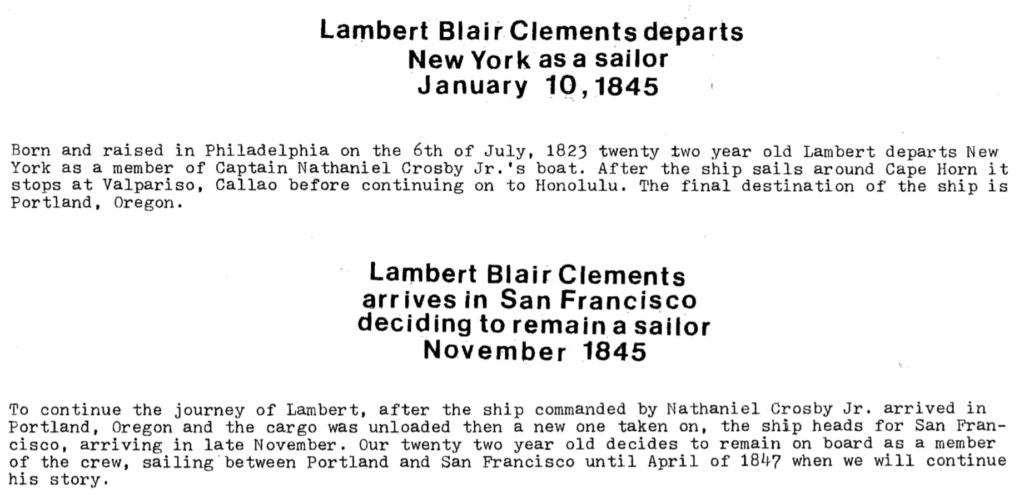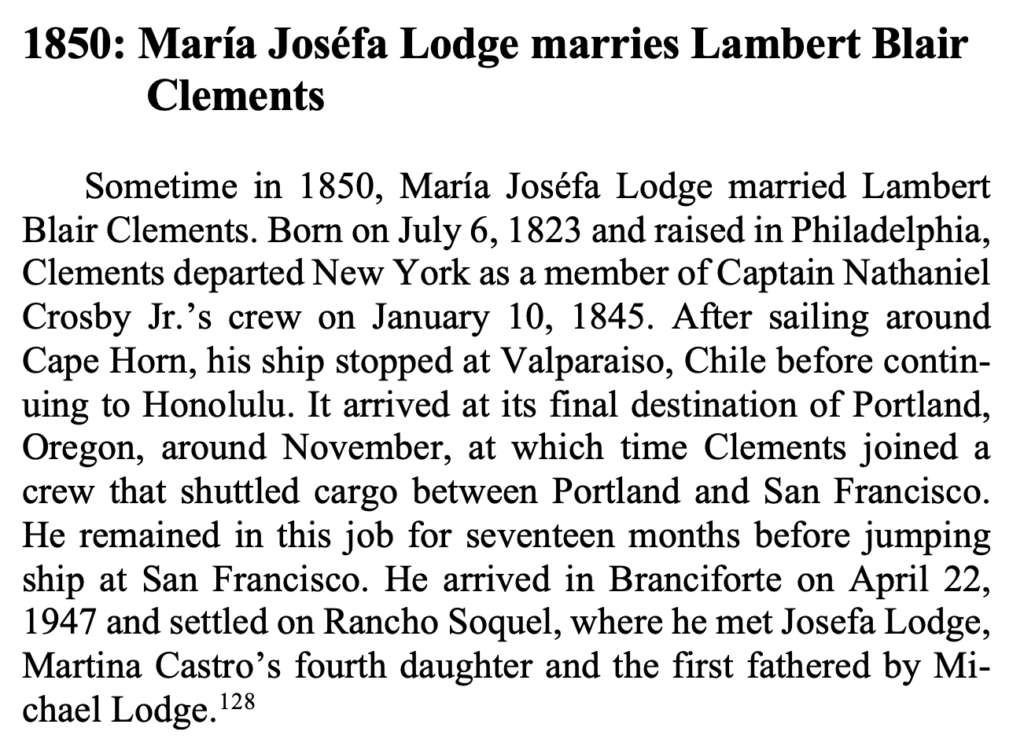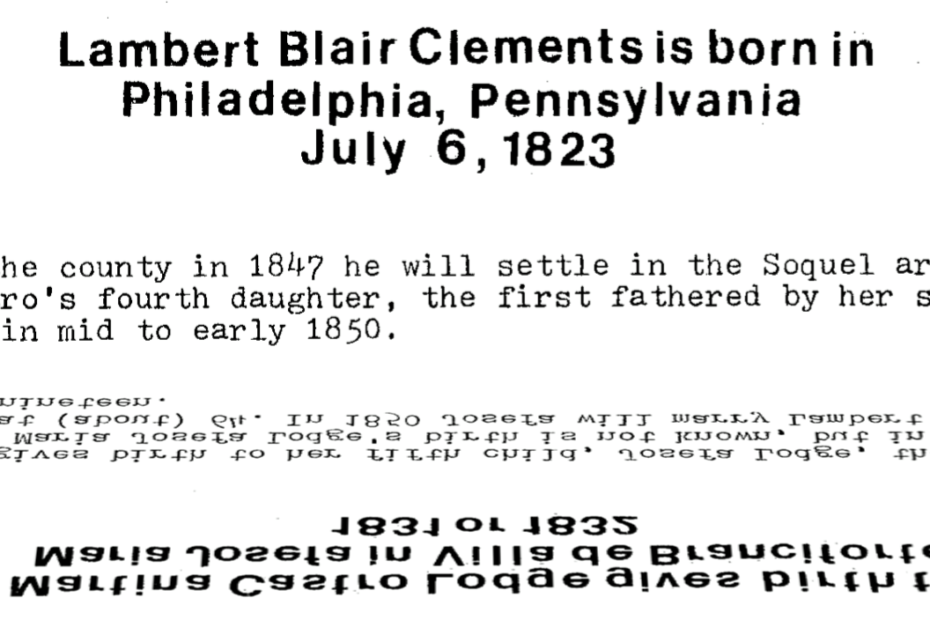When I began the task of converting Ronald G. Powell’s great history of Rancho Soquel to print in May, one obstacle that I did not expect was his heavily redundant writing style. Granted, the manuscript in my possession is a first draft and Powell never made a second one, but he had an extraordinarily idiosyncratic way of writing that, while predictable, has taken far more time to correct than I had originally anticipated. More than resolving text recognition issues, correcting typos, and occasionally addressing debunked or otherwise unsupported statements, fixing redundancies in Powell’s work has taken by far the most time. Rather than wax on about this issue abstractly, I will demonstrate this problem through an example directly from the text.

This chronicle-like entry introduces the reader to Lambert Blair Clements. It is dated to when he is born (this is a different issue that will be addressed in the next diary), when he settled in Santa Cruz County, and whom and when he married. But it also includes some information on his wife, María Joséfa Lodge, who in this case is more important but hasn’t actually been introduced in the story yet. You have to wait until an entry eight years later for her to appear:

With this entry, we are formally introduced to Josefa in a strange inverse of how we met her initially. Now she is the subject and her future husband is the one passively mentioned. There are a few other details here, mostly observations or obvious facts that could be derived from other entries, but the key takeaway is that most of the information here is redundant since we learned it already from her future husband’s entry (or surrounding information). It actually is part of an ongoing problem with Powell’s writing style: he is trying to both build suspense while simultaneously adhering religiously to a self-imposed chronicle style that leaves no room for said suspense. So he leaves these little clues, rather like telling the reader: “Stay tuned! This will be happening soon!” But that only really works once.
The story of Clements then diverts to tell of his adventures as a seaman. In somewhat unusual back-to-back entries, Powell records:

Again, we get Clements’s ancestry as a sort of catch-up mechanic before moving on to new information. Powell’s adherence to the chronicle style forces him to start a new entry for when Clements arrives in San Francisco rather than continuing the previous entry. Typically other material would slot in between these two, but not a lot happened in 1845 so these are uncharacteristically together. Despite that, Powell still reminds us of the captain’s name and Clements’s age, and informs us that he is now in Portland. When we see Clements again in 1847, we’ll be reminded of this period:

Again the ship ports are mentioned as well as the captain’s name. We do learn that Clements jumped ship finally to move to Branciforte. Powell also makes sure to remind the reader that Clements will eventually marry Joséfa. By the point where we actually see the two get married in 1850, several throw-away lines in previous passages have already told us that Joséfa was around 18 when she married and that she probably married to get away from her step-father. If Powell had been hoping for suspense, he could have saved these lines for later.

When we finally reach the wedding and the conclusion of this specific story arc, we mostly just get a repeat of what we have already read before. We get Clements’s entire origin story all over again, with a few new details about his Irish ancestors. We get a throw-away line about how the Irish appear to be everywhere in Santa Cruz, something that has already been stated several times in other entries. We get an admonition to “remember these three Irishmen!” who are so frequently discussed throughout the 1848-1856 period that it would be hard to overlook any of them. Then we return to Clements’s story of how he jumped ship at San Francisco and moved to Branciforte. This is followed with a reminder of who Joséfa is, with a rather confusing recounting of which daughter she is among Martina Castro’s children. The passage then ends with a hint at a future entry, which we will not follow for the sake of brevity.
In the end, there is actually a lot of good, well-researched information in these several passages. We learn quite a bit about Clements before he arrived in Santa Cruz County and we get a few hints about Joséfa, whom we unfortunately know little about. But there is no reason why all of this information needs to be spread across six entries and about 100 pages. So one of my tasks and goals, both to reduce redundancies and help the reader navigate the book better, has been to consolidate sprawling story arcs that do not take place within Santa Cruz County. Biographical arcs, such as Clements, is a great example. While his origins are interesting, what is really important is that he got to Santa Cruz and married into the Castro family. The other details don’t mean anything outside that context, which is why Powell repeatedly mentions Clements’s marriage to Joséfa before it actually occurs. So for this example, I have kept Joséfa’s first entry intact, but Clements doesn’t appear in the story on his own until his marriage in 1850:

All the essential details from the previous entries are here except for the Irish items, which are already mentioned elsewhere. I even kept the part about Joséfa’s parentage for the time-being, although that may get cut at a future date. In classical newspaper style, the most important information is at the top: the marriage. From there, it diverts to Clements’s story before bringing the two threads back together with Clements meeting Joséfa (I have fixed the missing accent on her name).
Remember, this is just one example! There are about three dozen more that follow a similar pattern, and other narratives also have heavy redundancy in places. This example above is also still a work in progress, especially with the header formatting and how to deal with items that don’t have specific dates—Powell couldn’t resolve that issue either. But the key takeaway is that I am trying to reduce redundancies wherever possible while not significantly altering Powell’s intent or even in most cases his writing. It is, after all, still his book. But nobody wants to read the same information ad nauseam. This book, which will be released in two volumes, will be massive. The current first volume is trending toward 800 pages! It will test the limits of Kindle Direct Publishing’s page count. So eliminating any fluff is absolutely necessary for everyone concerned.
